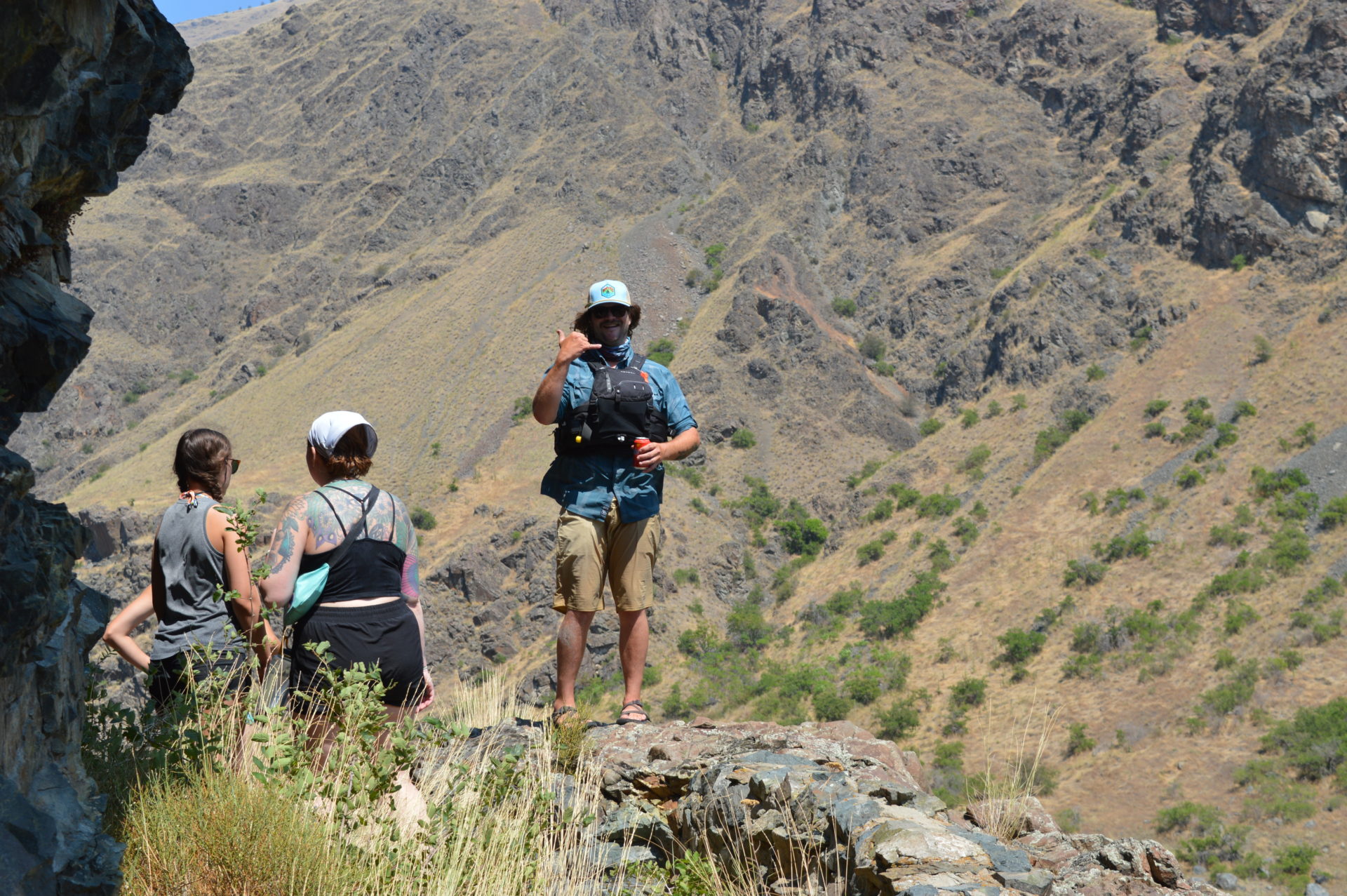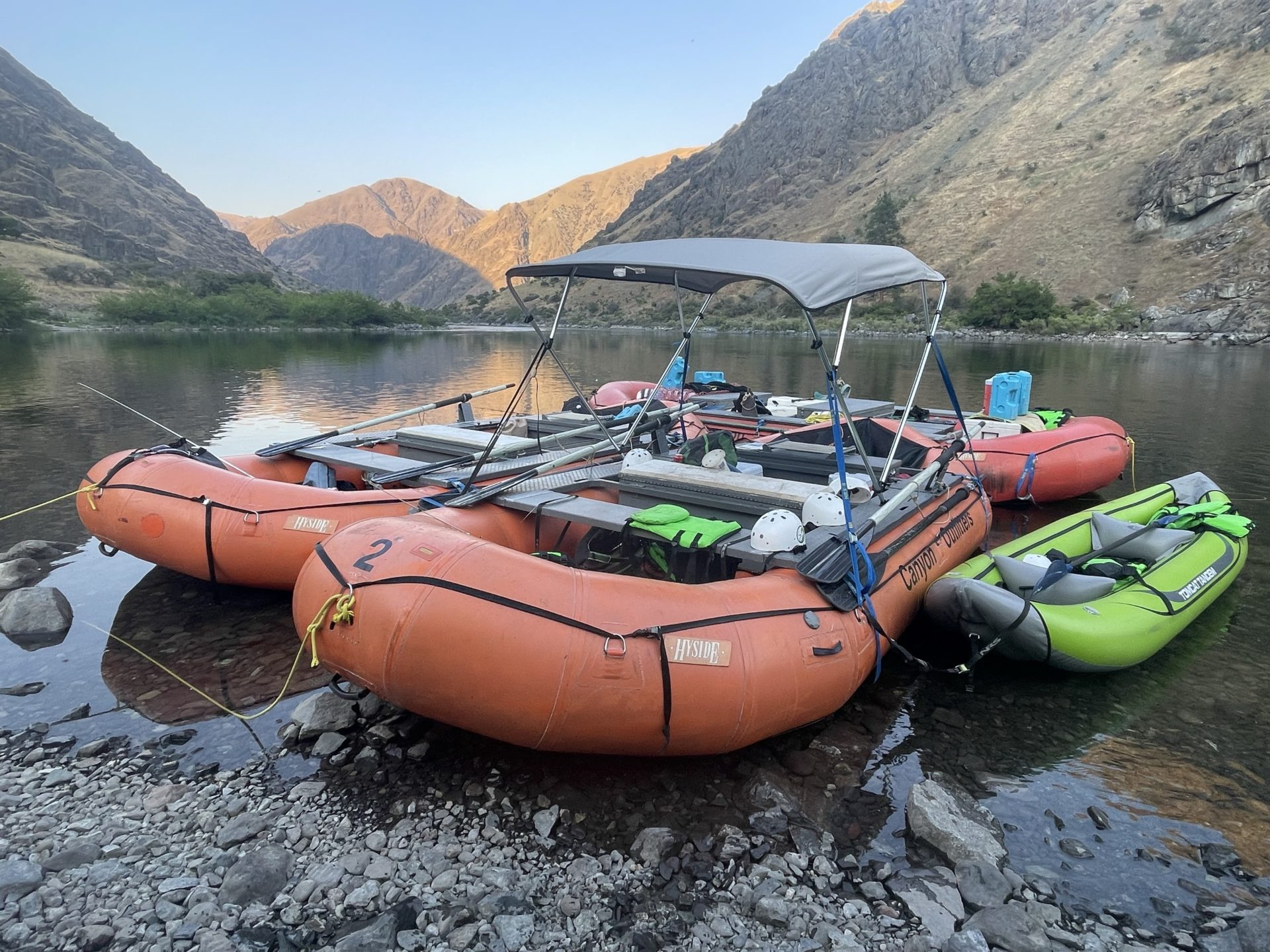
At over 8,000 feet at its deepest point, Hells Canyon along the Oregon and Idaho border is the deepest gorge in North America. The Snake River cuts through the epic canyon that was formed by violent tectonic plate collisions, underwater volcanoes, and immense lava flows. Within the canyon contains some of North America’s oldest anthropology discoveries, hundreds of human artifacts that are dated back as far as 16,000 years ago. Today, the canyon is a place of recreation, packed with fishing, whitewater rapids, hiking, and escaping into one of the most remote places in the lower 48.
Tributary Whitewater spread its reach to Hells Canyon in 2023, after it took over the operations of the recently retired George Hauptman, a legendary guide on the Snake River who spent over 40 years mastering the river. Tributary’s operation is based out of Halfway, Oregon, which can be referred to as “The middle of nowhere” or “three hours from Boise, Idaho,” and is located in the beautiful Wallowa Whitman National Forest. Small in size, Halfway has nearly 400 proud residents who smile and wave at each new visitor who is eager to explore the beauties of Eastern Oregon and Hells Canyon.
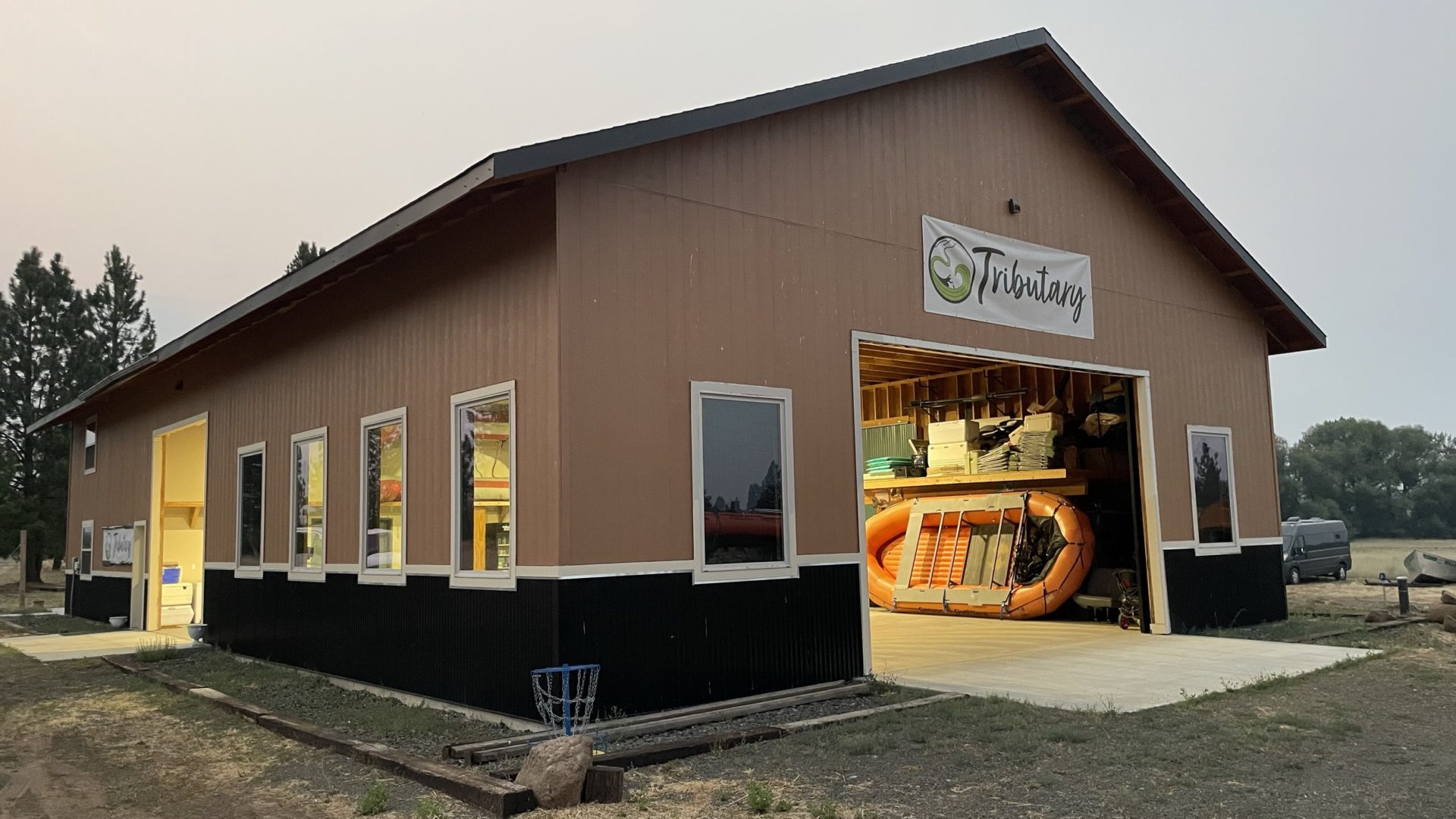
To kick off the four-day, three-night Hells Canyon adventure all the guides and guests meet up at Tributary’s outpost the night before to share a meal, get to know one another, and get stoked for the journey ahead. This July, I was fortunate enough to join Tributary on this adventure into the depths of Hells Canyon. And on Sunday, the night before we hit the river, we had a wonderful dinner and pre-trip meeting.
We connected with the trip’s chef, three guides, and eight other guests by sharing stories and eating a delicious meal. After getting to know everyone, our head guide, Chris walked us through the itinerary and items we needed to bring to be ready to roll the next morning. He explained that the guides would be hauling out nearly everything you could imagine besides the clothes and whatever snacks you wanted to stash away.
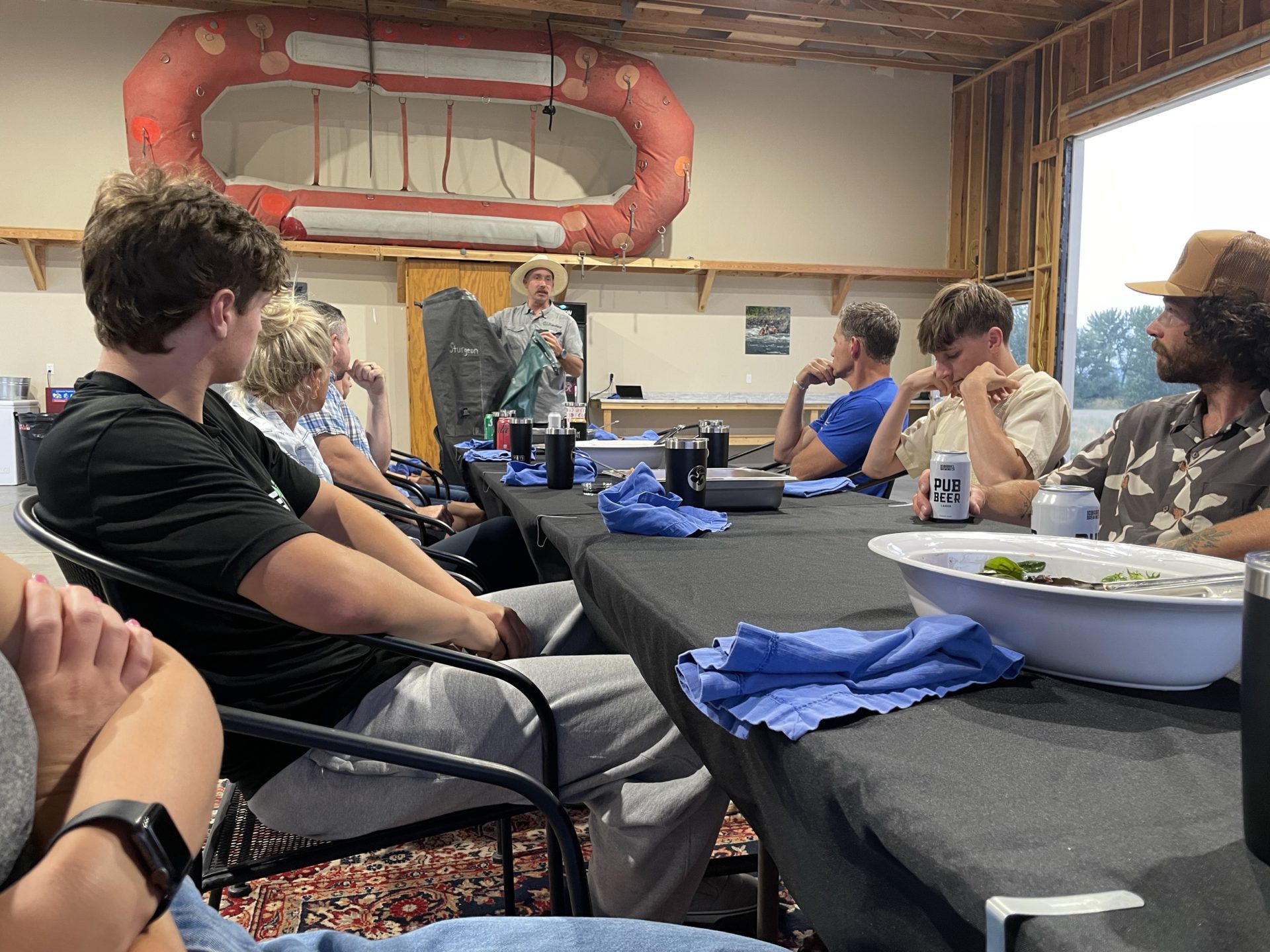
Before we left for the night, each guest was lent two dry bags that would be used to store our personal items on the trip. One was big enough to crawl inside, and it was used to hold any items that would be put away for the day on the 22-foot gearboat. The other much smaller bag acted as a day bag and would be accessible through the day so I kept things like sunscreen, water, and my camera in there.
It felt like a fairytale leaving the outpost that night. I once was a river guide back in Colorado, but I never ran a multi-day trip, and that was soon to change.
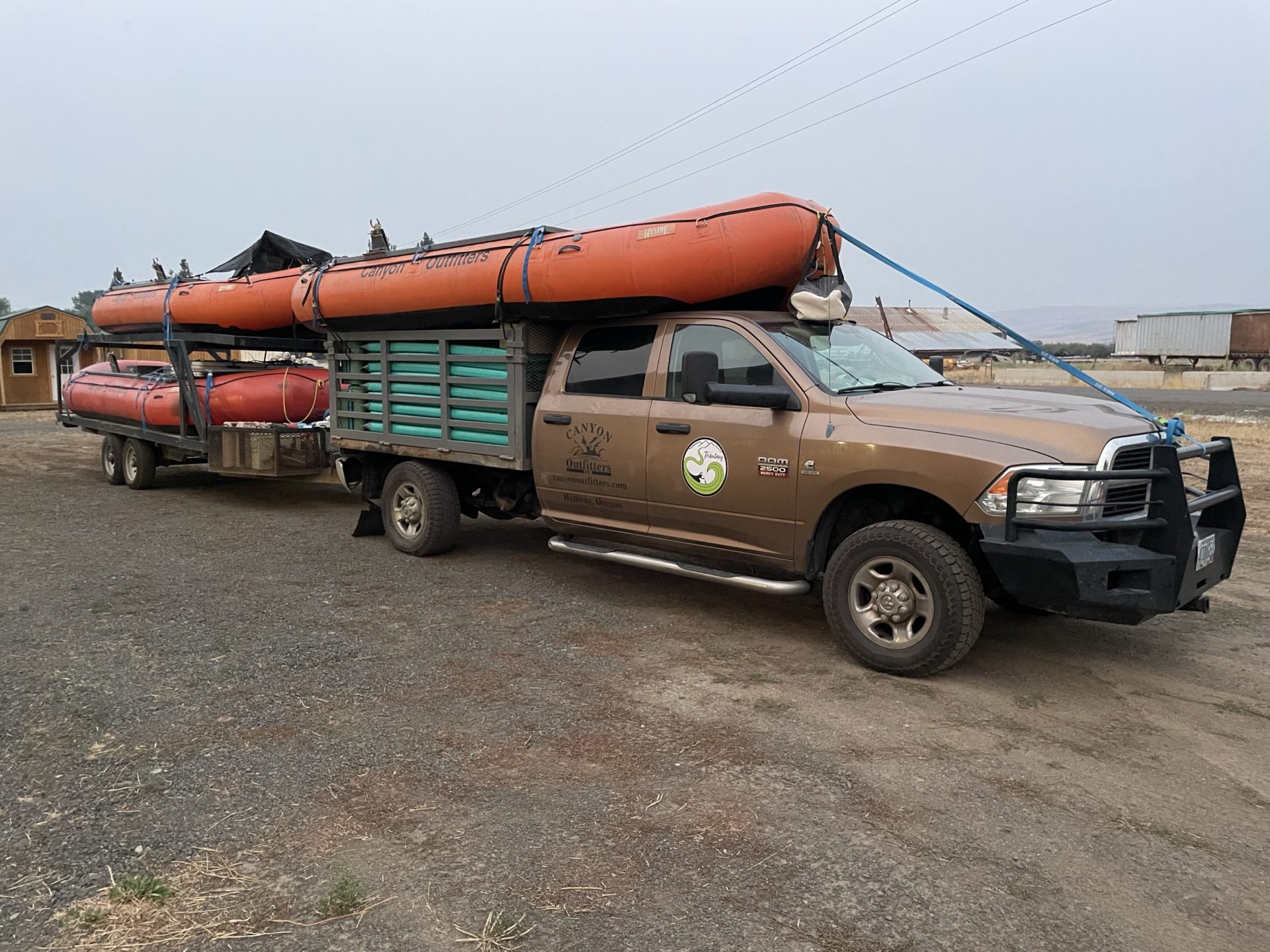
Day 1
The next morning we all met back at the outpost to load the van up and set off for our one-and-a-half-hour drive to Hells Canyon Dam. Everyone was humming with energy as we drove further into the canyon, taking in our environment for the next few days. The terrain changed quickly as we went from the small mountain town to the depths of North America’s deepest canyon. The guides handled all aspects of the trip with a safety-first approach, including navigating the remnants of recent wildfires as we headed out on our journey.
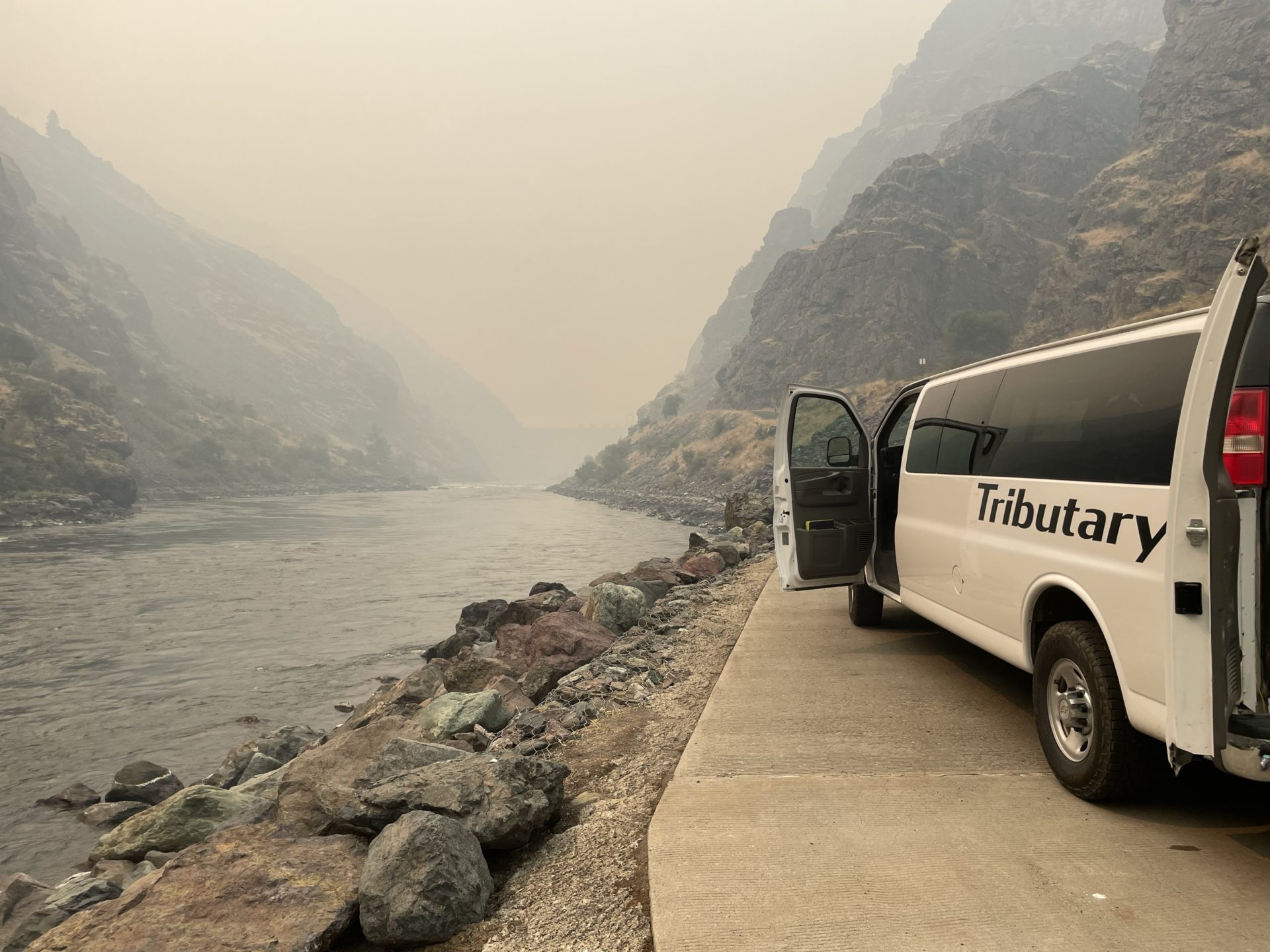
The beautiful drive concluded, we made it to Hells Canyon Dam, and the guides loaded up the boats.
- One 22-foot boat charged ahead with kitchen supplies, camping gear, our large dry bags, and much more
- Two 18-foot boats splashed behind with us guests and fishing rods to catch smallmouth bass and rainbow trout
- One “ducky” or inflatable kayak that could pack two people
- And one inflatable paddle board for anyone who dared to send a rapid
Typically, the inflatable paddle board was stored away as we floated, and we all spread amongst the two passenger boats and inflatable kayak. We set off from the dam around 11 am with a short day of six miles planned. We floated past the towering canyon walls, often capturing a glimpse of the massive peaks that extend thousands of feet above the river surface. The water was beautiful, clear with a dark emerald hue to it. We floated through small rapids chatting and fishing, and in no time we reached the lunch spot for the day.
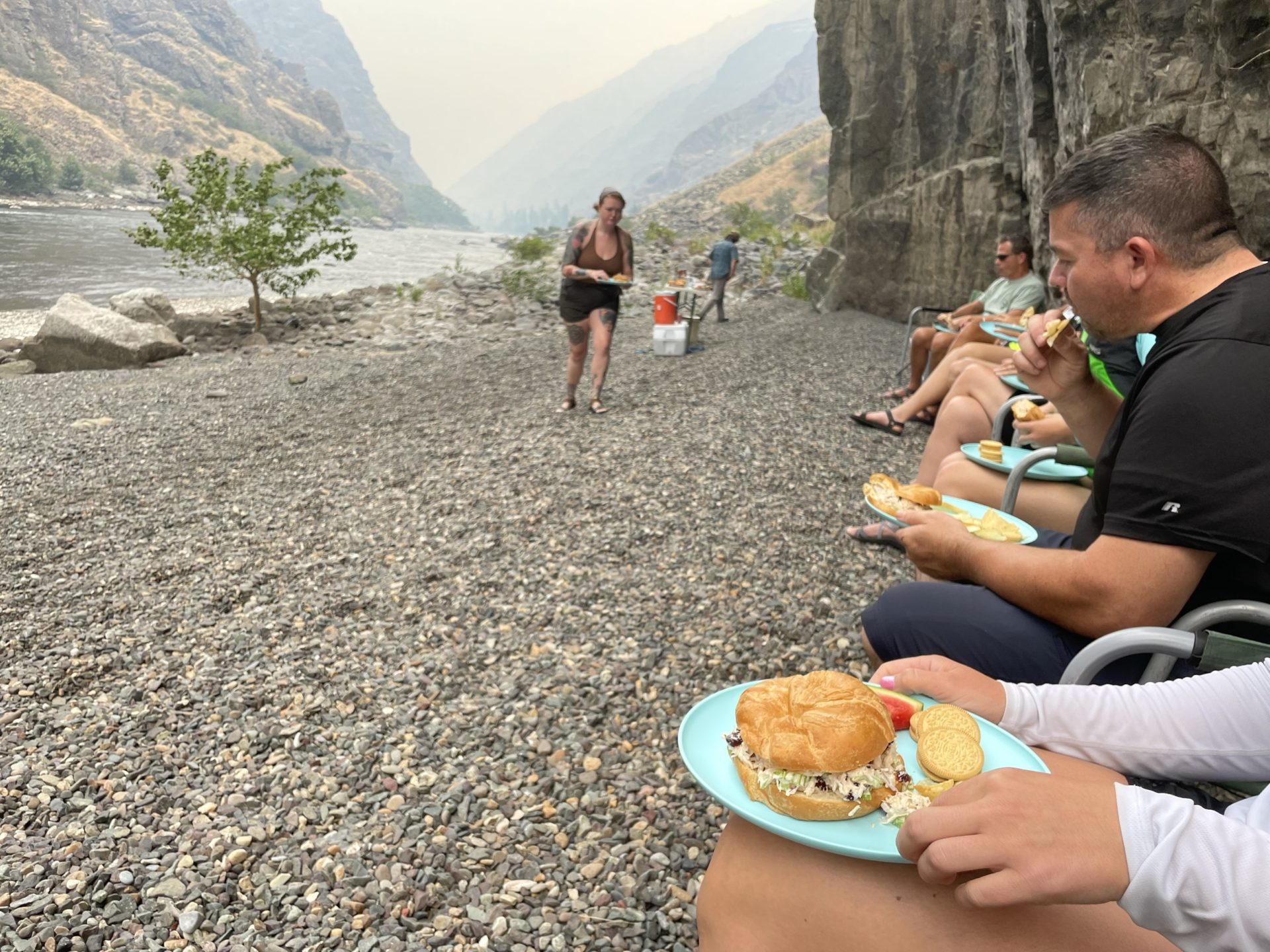
Within minutes of arriving at the beach, the guides had lunch prepared and chairs set up for all the guests. We munched on chicken salad, watermelon, chips, and Oreos as we admired the sheer size of the river and canyon we were now deep within.
After lunch and a swim break in the eddy, we took off for more fun whitewater ahead. After a few smaller rapids we took a pit stop to witness some of the oldest pictographs in North America. Dated to be thousands of years old, the remnants of the red pictographs were only able to tell a fraction of the original story they once displayed.
It was awakening to see the lands the Nimiipuu (Nez Perce), Cayuse, Umatilla, Walla Walla, and Palouse Tribes all called home for many years. Understanding the history of the land and the communities that thrived in this region gave us all great appreciation for the many generations that thrived in this environment.
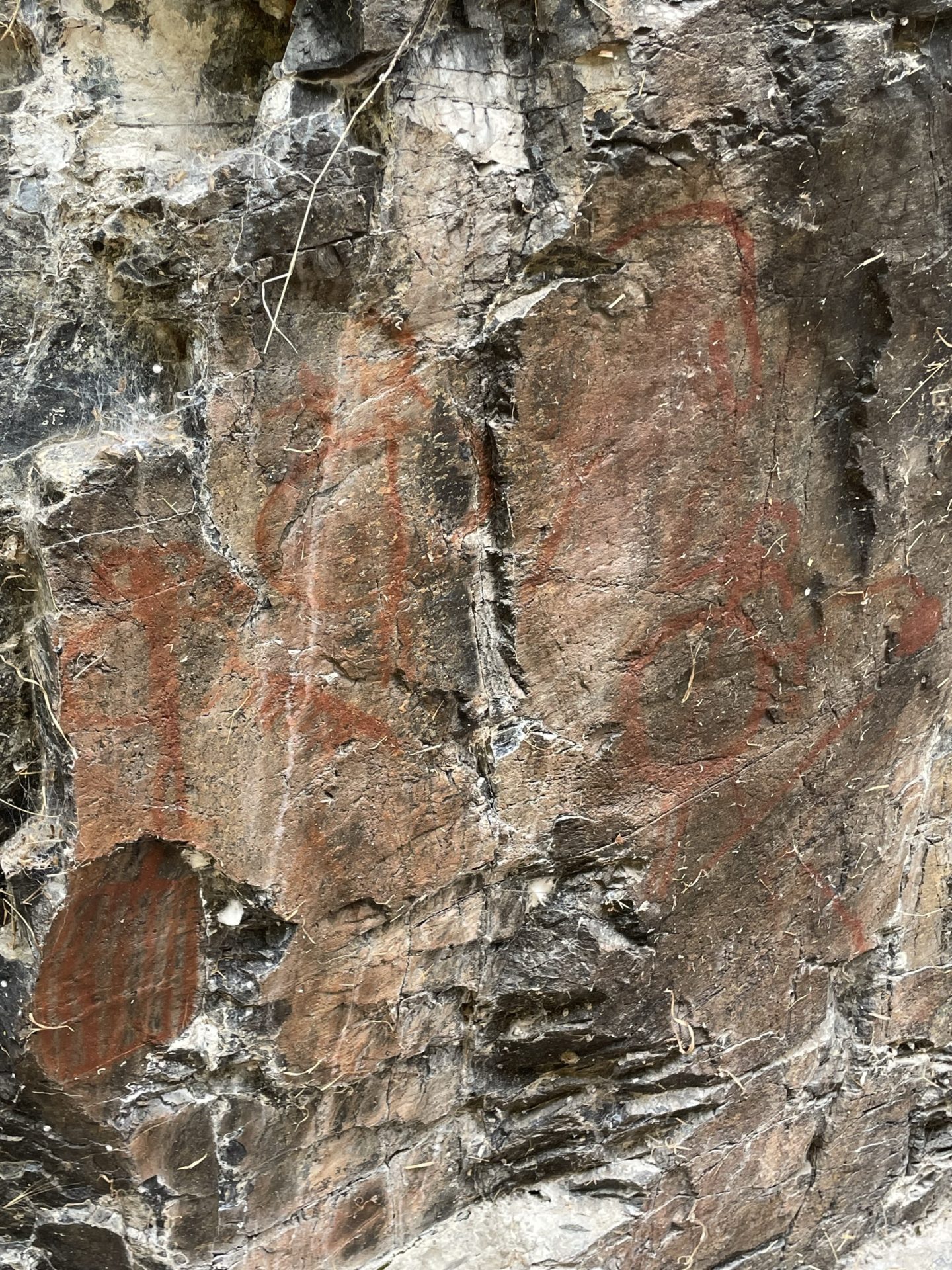
We finished out the last mile and a half, arriving at our first campsite at Barton Homestead near Battle Creek around 2:30 pm. The campsite was a short walk up a hill that provided a great view downstream of the river where I could almost catch a glimpse of Wild Sheep Rapid, a class four rapid that churned endlessly.
Surrounded by groves of apricot trees and blackberry bushes, the Barton Homestead remains standing after being constructed over 100 years ago. I was surprised how the old orchard flourished and that people had ranches and drove cattle in the depths of Hells Canyon. Mule deer lurked in the orchard, munching on fruit and attempting to stay hidden.
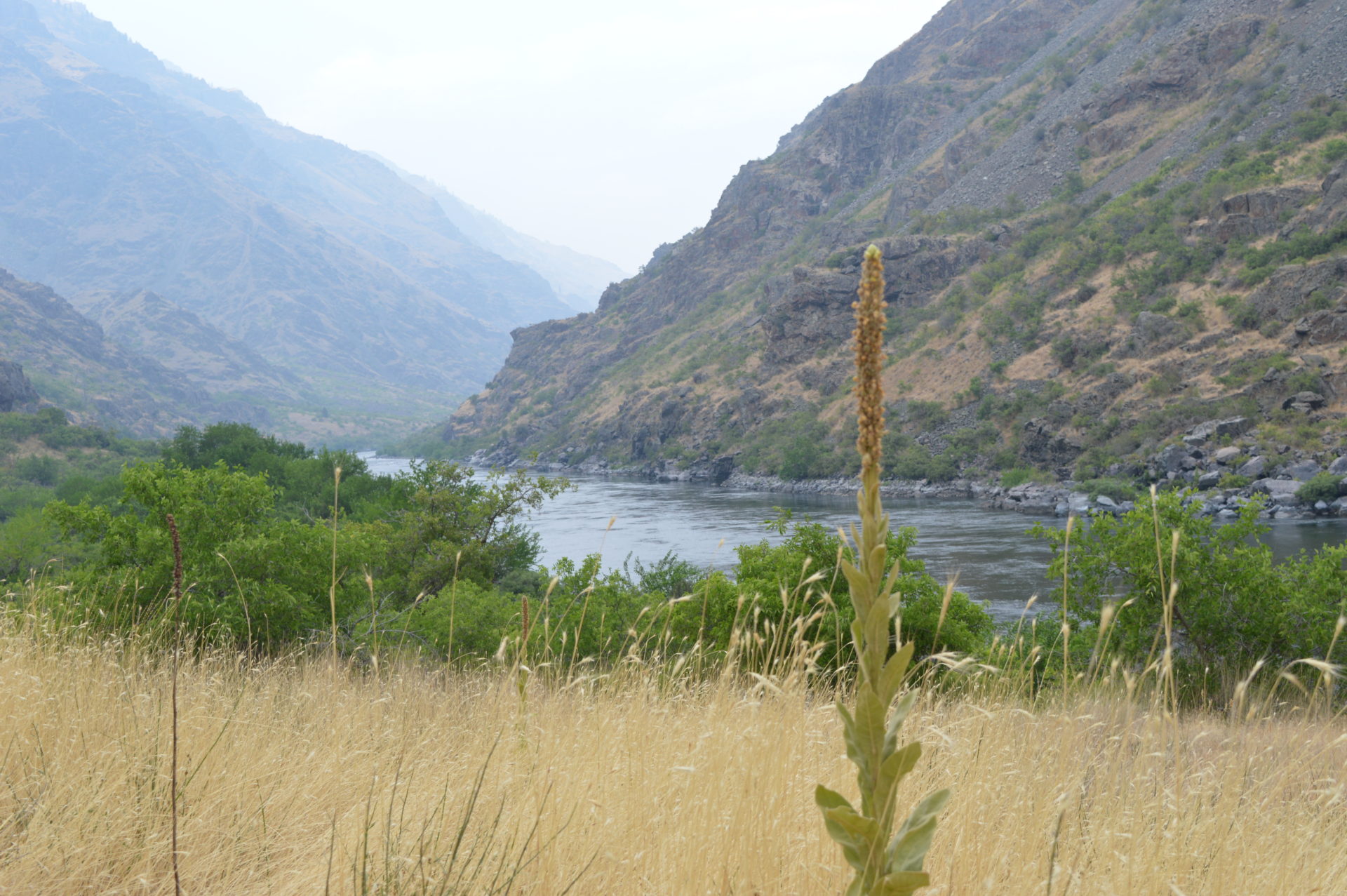
The in-between time from getting to camp and eating dinner was spent hiking, exploring the old homestead, fishing, swimming, and hanging out with everyone over a beer or two. Speaking of dinner, Tributary put together a ridiculous dish of steak topped with chimichurri sauce, golden potatoes, salad, and a Dutch oven-baked mega cookie that we all feasted on.
Winding down the first day, we all sat around a propane campfire just off the shore where we shared stories, dug a little deeper into each other’s lives, and reminisced on the day. The stoke grew for the next day as the guides shared details of the incredible whitewater we were set to traverse tomorrow. As the night went on the sky continued to reveal itself and the twinkling night sky that watches over the remote canyon.
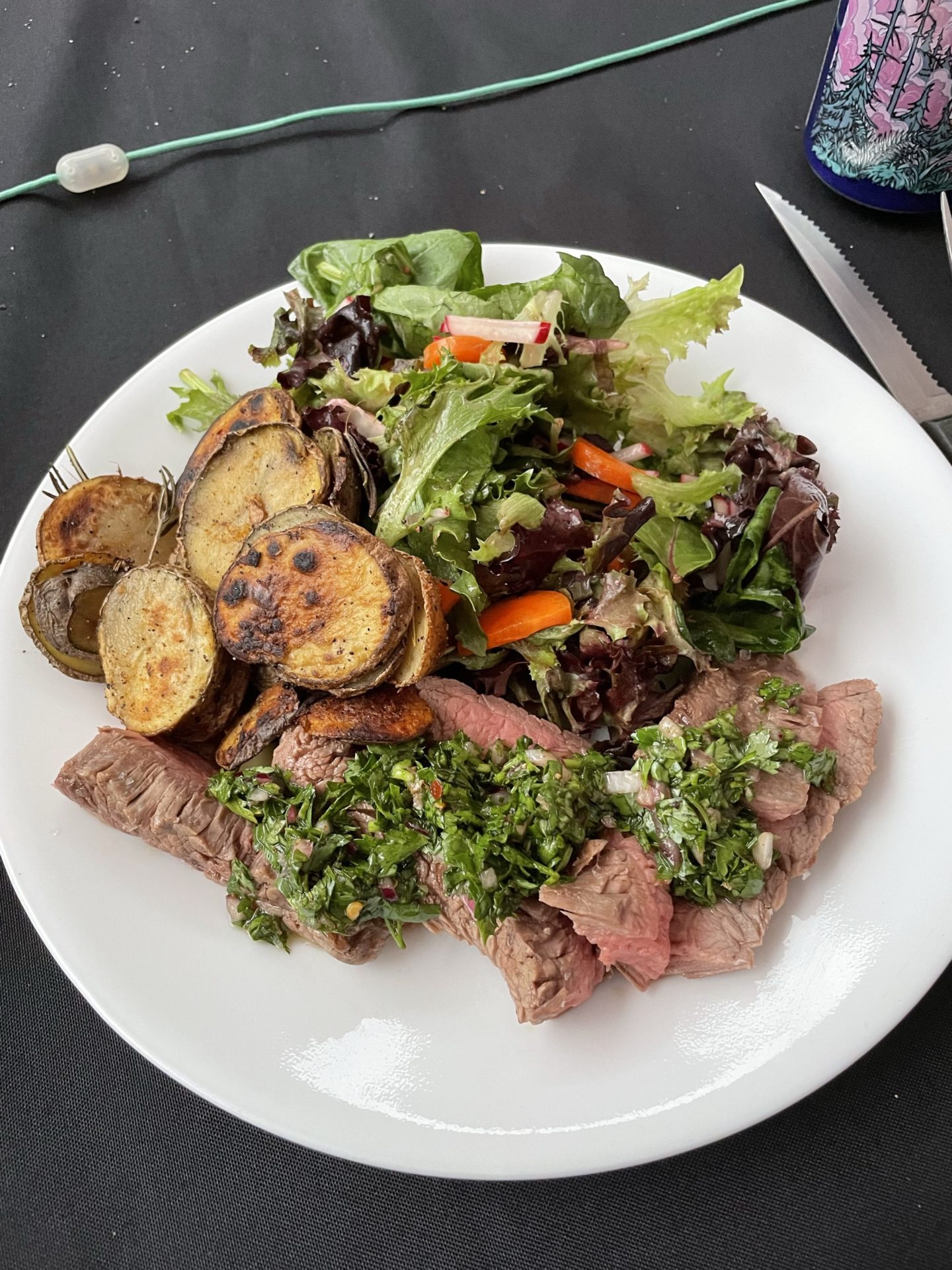
Day 2
I woke up to the smell of coffee and breakfast sizzling on the griddle. The camp setup was excellent and the cots made for a wonderful night’s sleep. Before heading out on the river, we had an amazing breakfast of eggs, potatoes, bacon, yogurt, fruit, and coffee. By the time we were done with our relaxing morning, I was itching to get back on the water. Just minutes away, the largest and gnarliest rapid of the trip, Wild Sheep Rapid (Class IV) was waiting to greet us. The guides quickly loaded the boats again, and we set off around 10:30 am.
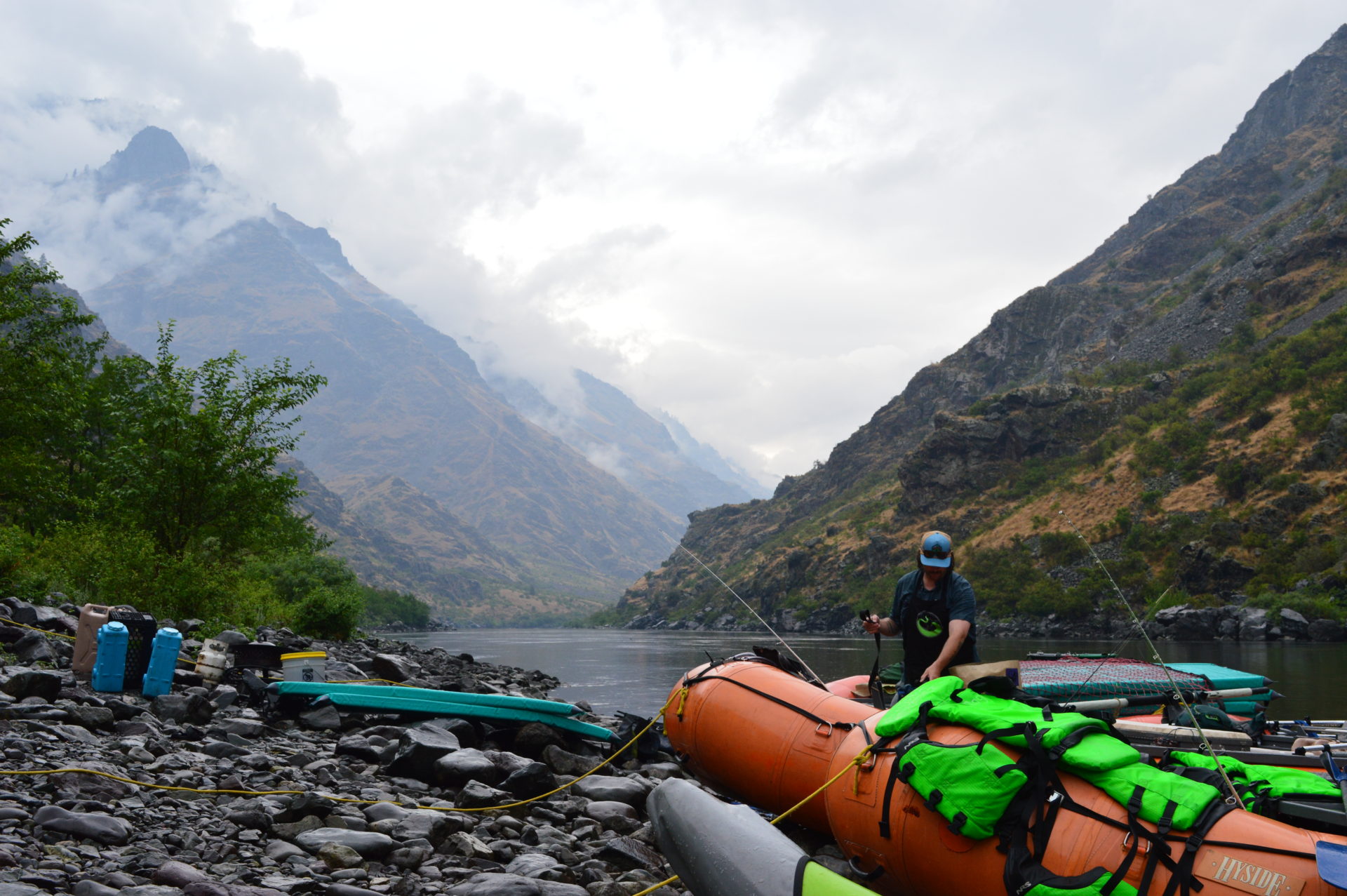
The guides educated us on the rapid, and we scouted the section from the hillside. Our head guide, Chris, provided us with a ton of great information and tips on how to approach the rapid in the kayak. Doubled up in the kayak with one of the other guests who was just as excited to paddle these waves as I was, we couldn’t wait to get out there. The line through the rapid was not technical, however, the initial approach was important to place us on a clean line through the three separate waves that made Wild Sheep. The other guests elected to take the rafts down this section, which made for a great splash.
Dropping in with the kayak, we charged the first wave beautifully, we maneuvered right to square up the next wave. Crushing the second wave, we acted quickly and pivoted left to hit the final wave that came in from the other direction. Our fluid paddle strokes pushed us over the last wave, splashing us with water.
The push of the final wave was enough to knock my co-pilot off the kayak. He quickly latched onto the kayak and pulled himself back onboard. After he was situated again, we laughed and celebrated with a high-five. The rapid was the perfect taste of excitement and adventure for everyone in the party.
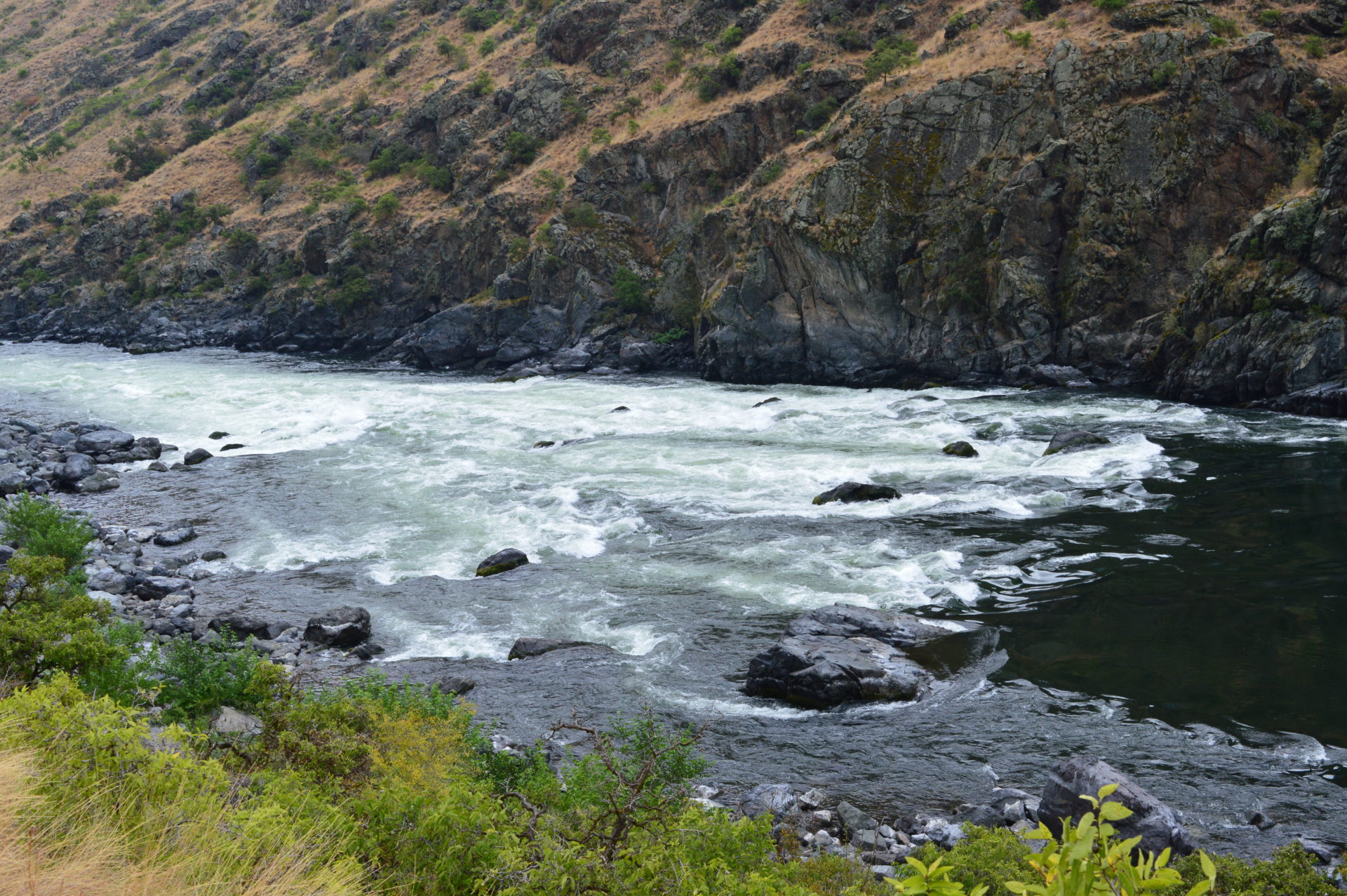
The adrenaline was back! The rush of barreling up a rapid and escaping the grasp of 10,000+ cubic feet per second of whitewater surged through my body. The Snake River delivered and we were all stoked to have sent Wild Sheep Rapid.
To keep the stoke high, we sent a few more great rapids called Granite Rapid, Waterspout Rapid, and both Upper and Lower Bernard Creek Rapids. Granite Rapid was aesthetically beautiful, it had a huge glass tongue that dropped right into a massive wave. A simple line, but it was charged with the biggest drop we encountered on the trip.
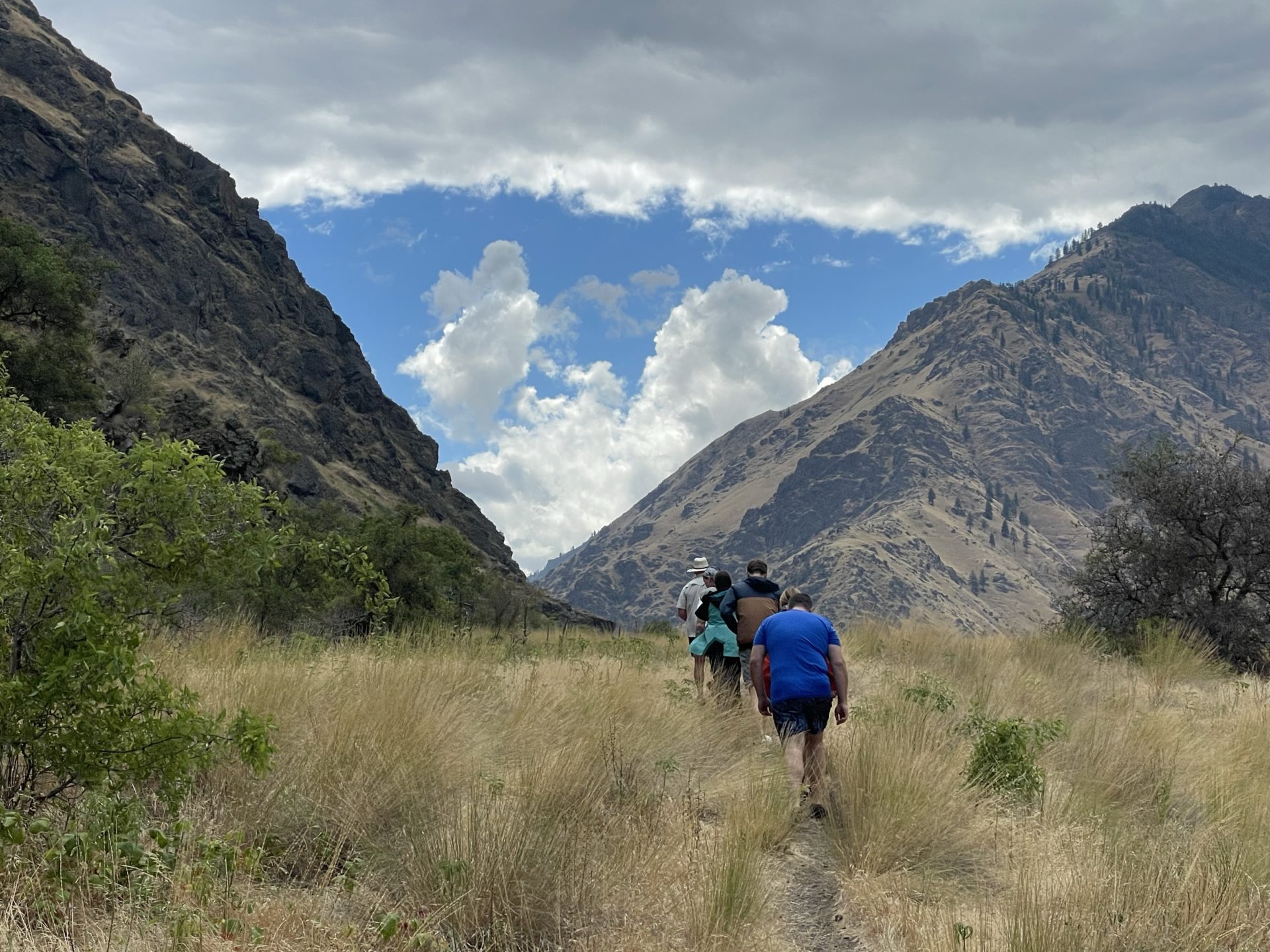
We made a couple of stops that afternoon, with one being another great display of pictographs from the Nez Perce. The other was at the McGaffee cabin, which was originally built in 1905 and later abandoned in 1935 after two owners homesteaded on the land. The property was abundant with grape vines and tomatillo plants.
After an exciting 13 miles on the river, we arrived at our highly anticipated destination. Wild Sheep Creek Campground is a unique property due to the irrigation system running through the camp to feed its thick, green grass and countless apple trees. This lush campground in the middle of the desert canyon is described as an oasis.
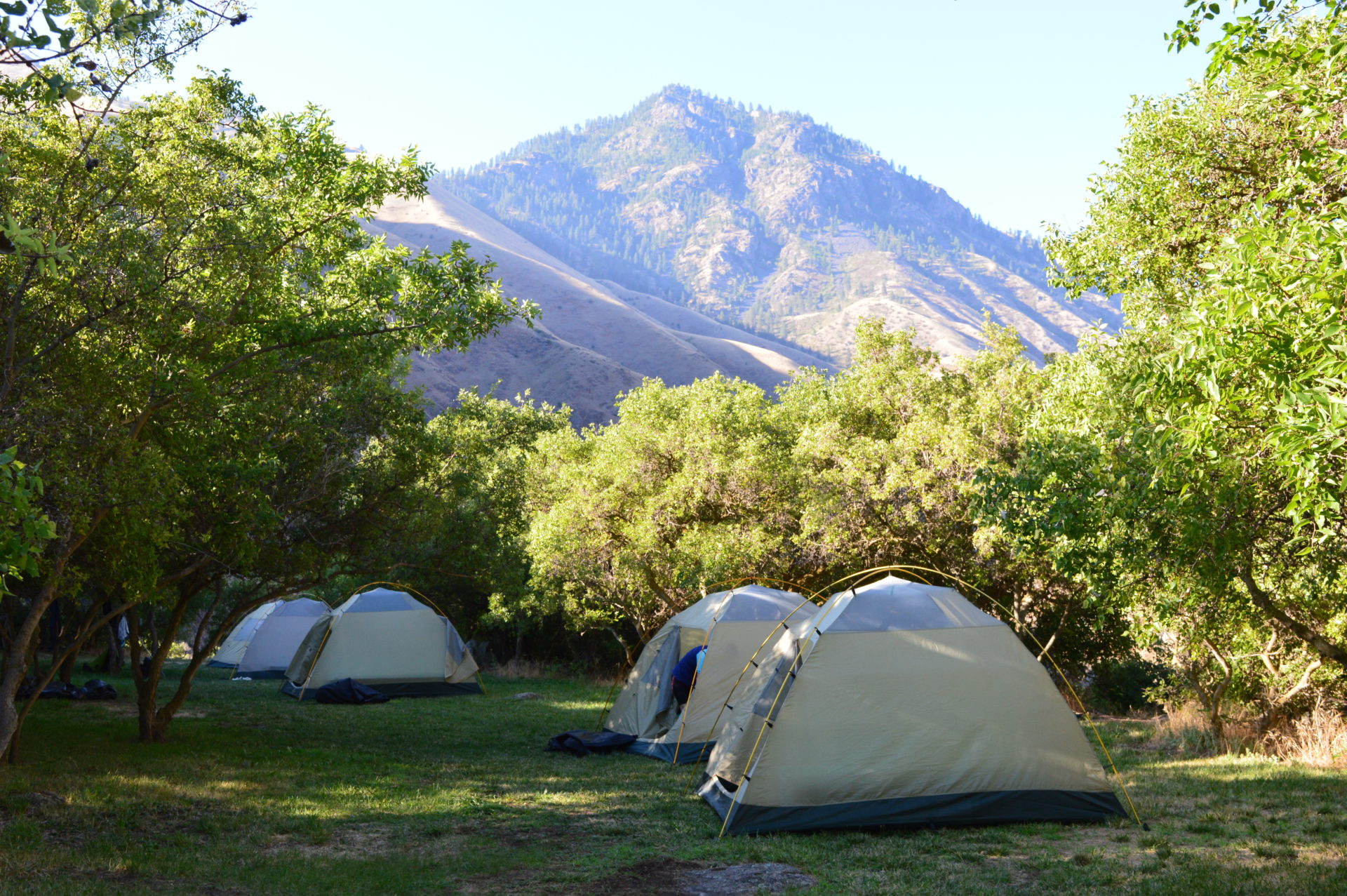
We spent the afternoon in the shade of the apple trees, playing horseshoes and lounging around reading. The beautiful waterfront at the base of camp made for great fishing, and I caught more smallmouth bass that evening before dinner. That night we feasted on fish tacos and a delicious lemon cake for dessert. You couldn’t go hungry if you tried! The meals have been incredible and beyond what I could imagine for a trip down the river.
The night crept up on us as we were eating and reminiscing about the fantastic day we had on the river. We transited to the fire ring and all connected over the marvelous trip we have had so far. Disconnecting from the “real world” and immersing into this river fantasy was exactly what we all needed. For the time, things were simple; raft, explore, fish, and relax with the group.
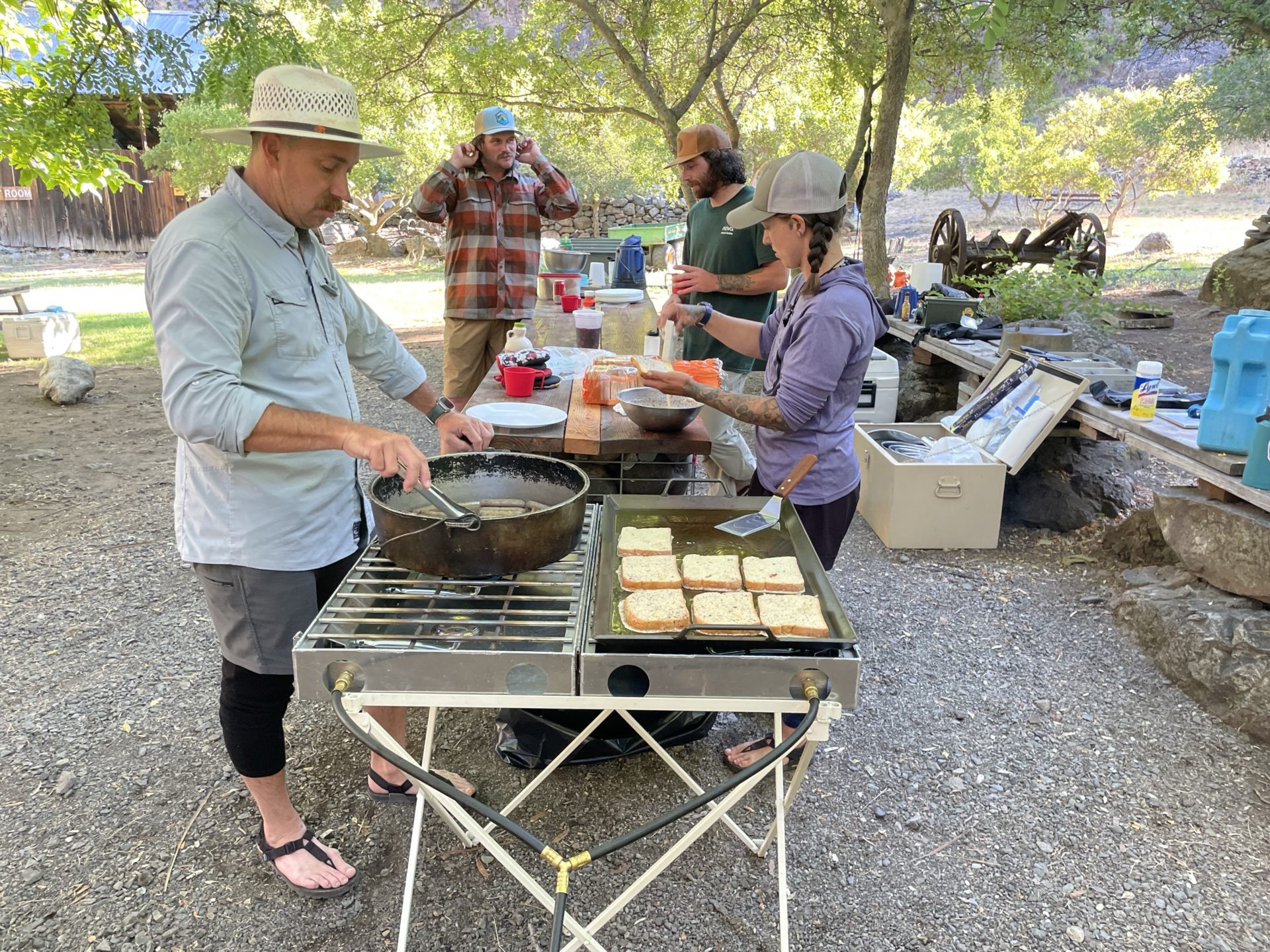
Day 3
A few of us started the day off with a cold plunge in Sheep Creek, followed by another delectable breakfast. The plan for the day was to enjoy the oasis at camp until 1 pm when we would take off for a short six or seven miles to our next camp.
The morning was spent fishing and looping the eddy on the paddle board. I even had time to head upstream to catch the Sheep Creek Rapid and attempt it on the paddle board. After a couple of hours of splashing around, we geared up and set off for another day on the river.
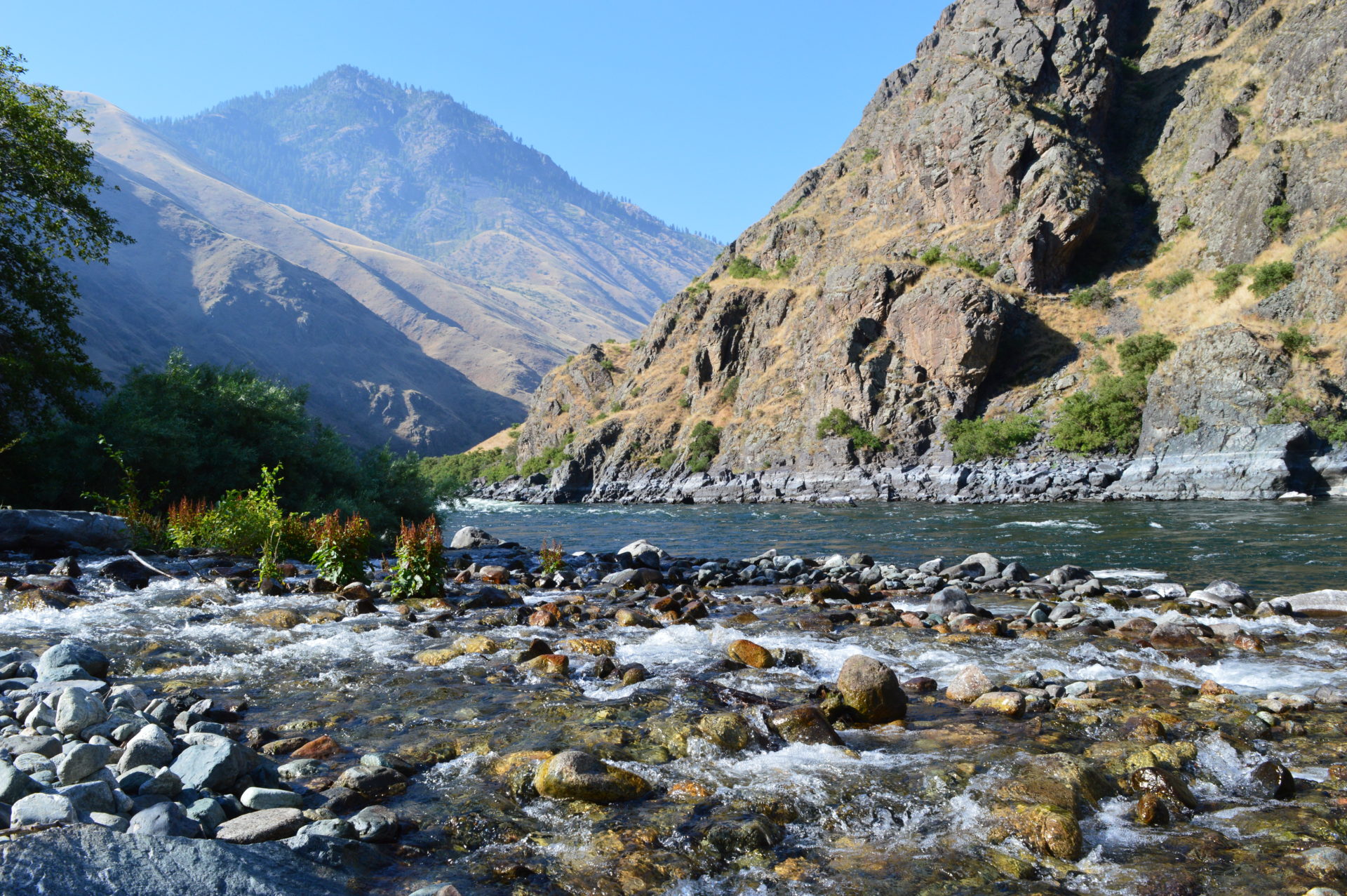
Not a cloud in sight, we floated down the canyon which by now had opened up a little bit more. The river was wider and slower, and the rapids were much more tame today as it made for a relaxing day. Our first stop of the day was at Eagle’s Nest, a lookout that was maybe a couple hundred feet from the surface of the water.
Shortly after the Eagle’s Nest stop, we all tied off at Sturgeon Rock, a perfect place to jump in for a swim. Sturgeon Rock was actually two rocks that made up the great swimming spot. They both were about 15 feet high and tons of fun jumping off and into the Snake River for a refreshing dip.

The last couple miles the river was pretty mellow, which most of us swam alongside the boats staying cool and having fun.
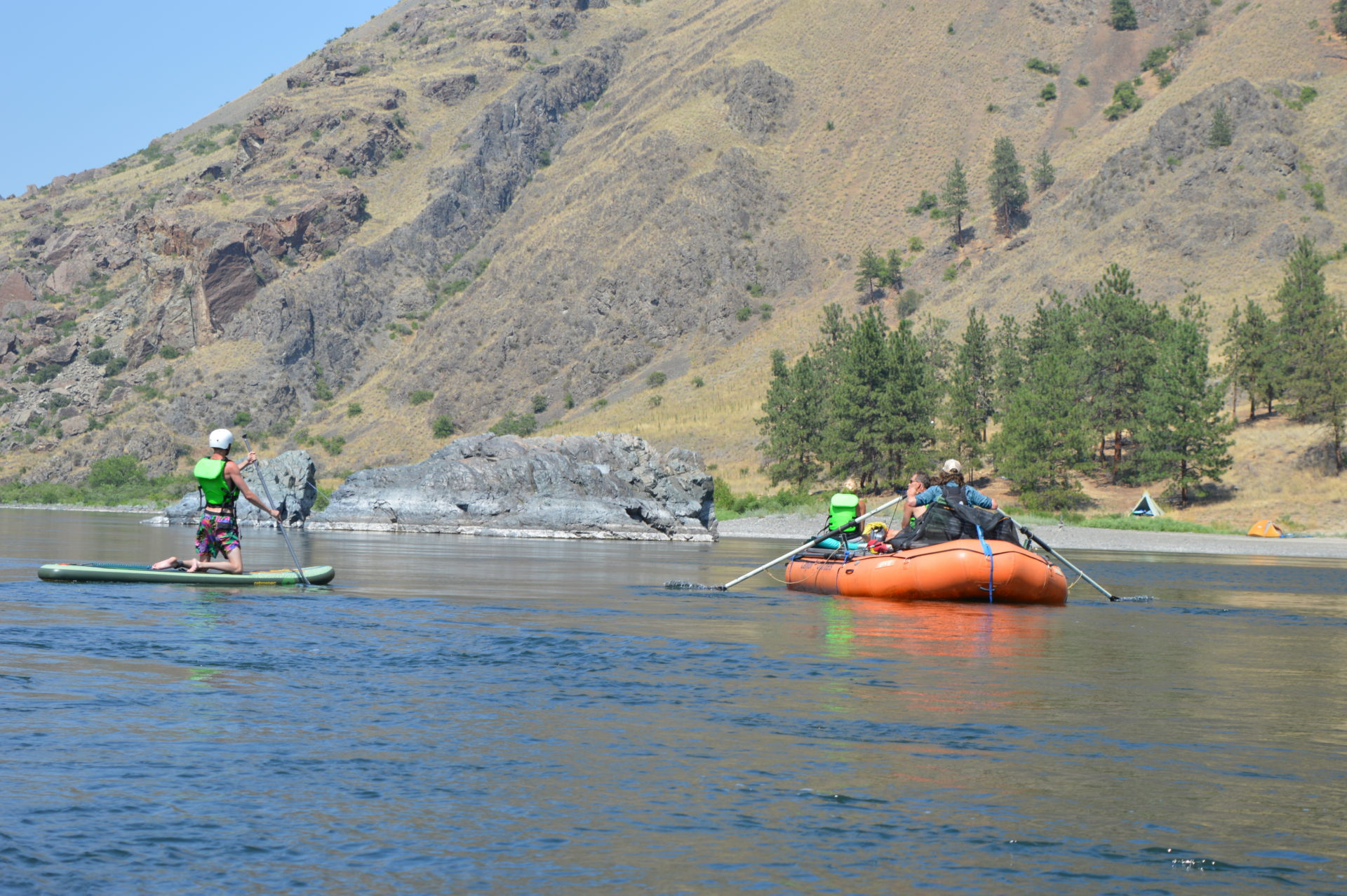
We reached Salt Creek Campground around 4:30 pm which was just enough time for fishing, a couple beers, and a short hike around camp. Rainbow trout and smallmouth bass were being reeled in left and right, but we had our eyes set on something bigger, a sturgeon.
Sturgeon are massive, prehistoric fish that can exceed 10 feet long in the Snake River. These giant creatures can seem elusive and are much harder to catch than the abundant smallmouth in this river. We baited a line with a trout and set out to reel in a legendary fish.
Ultimately the sea monster of the Snake would have to wait another day to reveal itself. No luck, but at least dinner was ready. Chicken stir fry and of course, we were treated to another Dutch oven dessert of brownies.

That night was spent kicking it with the guides out on the tied-up boats. It was a bit of a celebratory feeling that night, knowing we only had one evening and a few short river miles left to go. Reflecting on the trip, our group realized how close we had become in just a few days. The bond created during an adventure, especially a fun multi-day trip like this, is strong. We had all connected in one way or another, whether it was from an exciting rapid, a meal, or chatting around the campfire.
Day 4
The final day. I wasn’t ready to be pulled off the river, but today was our last stretch before we hopped on the jet boat to zoom back up the river. It was our shortest day on the Snake, around three or four miles in total, ending at the Kirkwood Ranch take-out point. This was also the point when three of the guides took off for Pittsburg Landing where the van and trailers awaited their arrival.
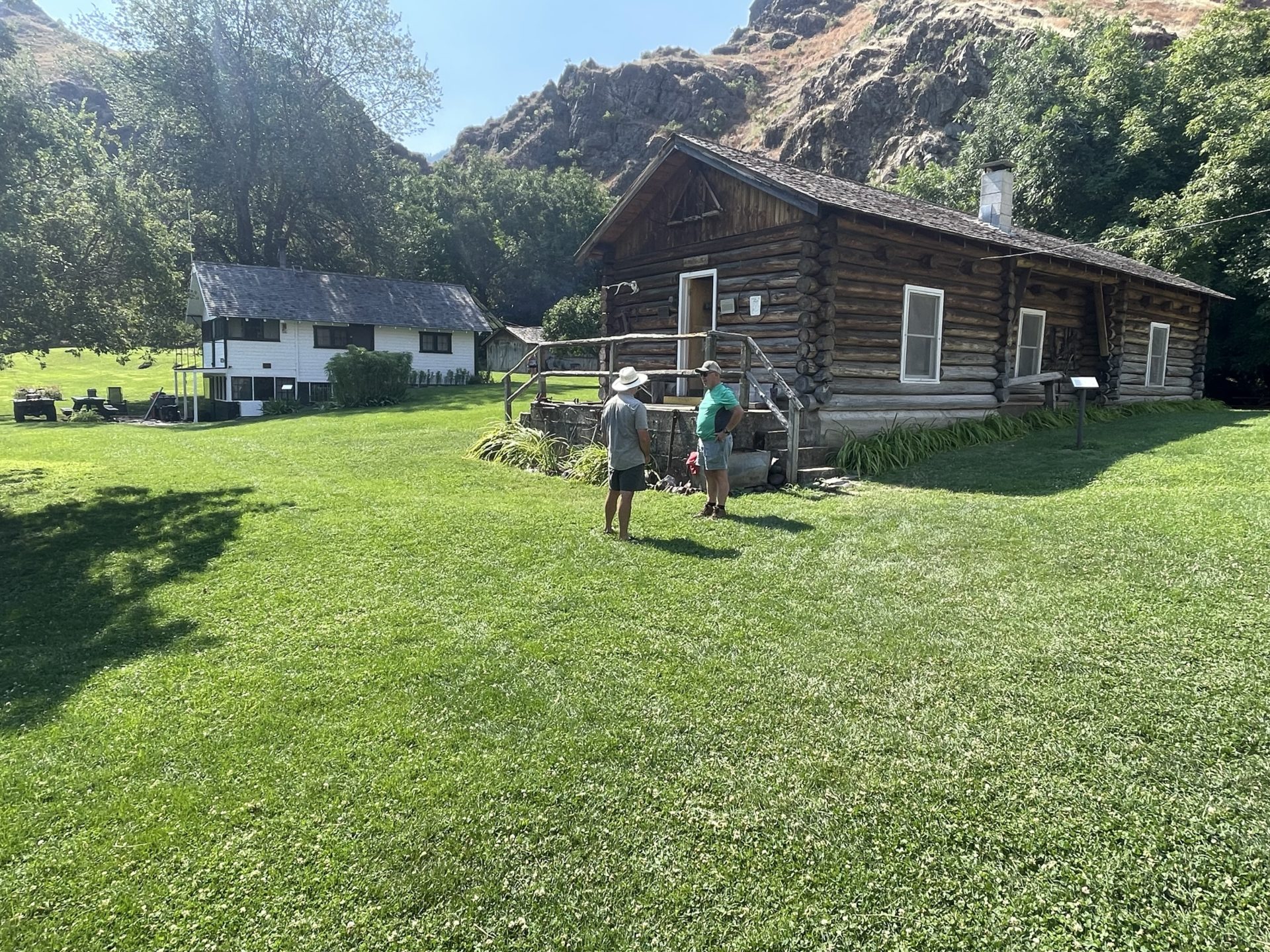
We all took our time saying goodbye and thanking the guides for such an amazing trip. As much as I wanted to tag along for another stretch of the Snake River, I was stoked about the idea of taking a jet boat up the rapids.
Before we jumped on the jet boat, we explored one last homestead. The Kirkwood Ranch is rich in history that dates back to 1885 when the first two cabins were built. A few different families took their shot at running a ranch on the property, and at one point the Wilson Family ran a sheep operation that was based out of Kirkwood and had 4,800 sheep. The sheep ranch proved to be lucrative and the family continued its operations until 1975, when Congress designated the Hells Canyon National Recreation Area.
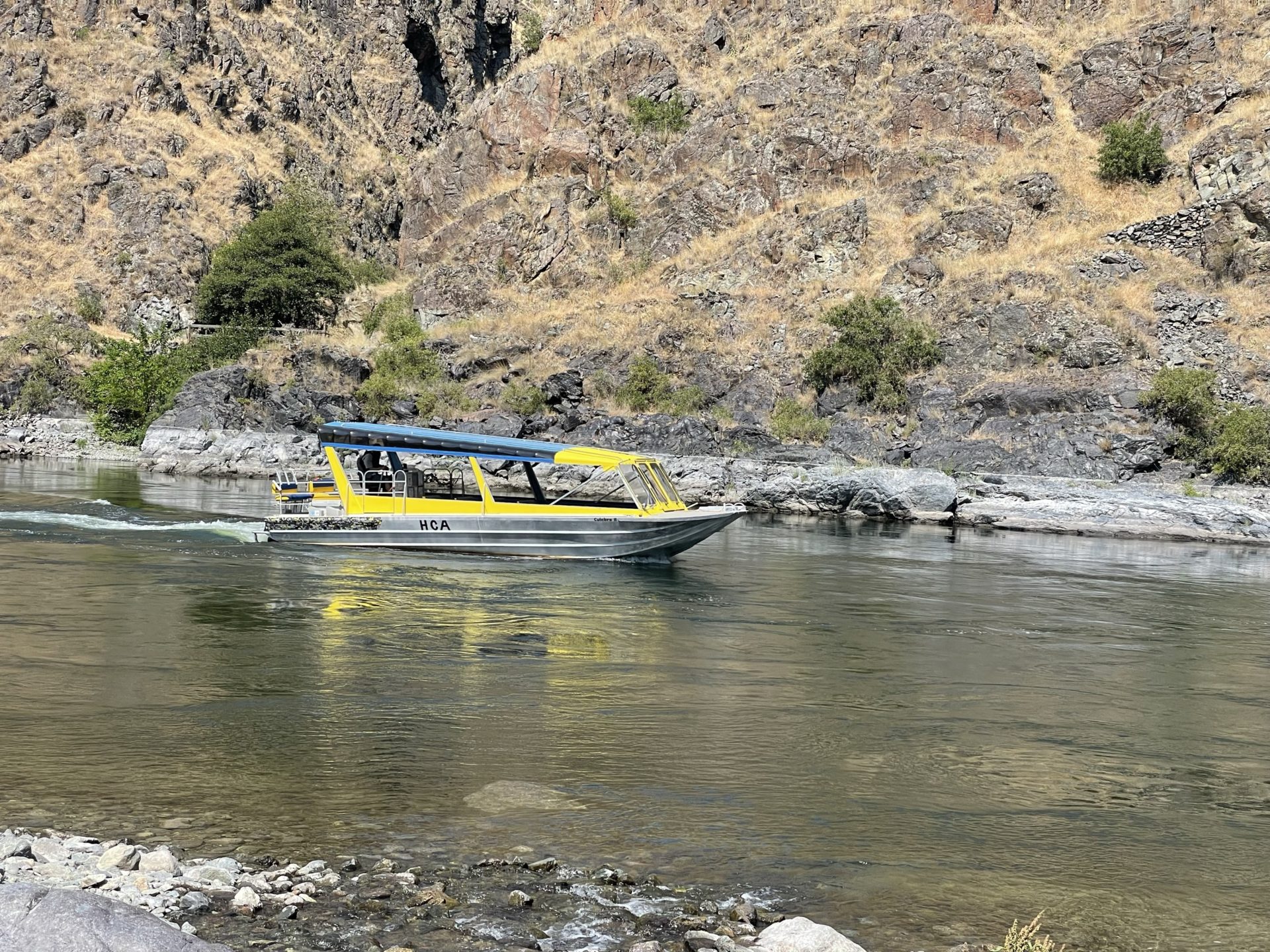
The jet boat rolled up to the ranch around 11 am, and I couldn’t believe that this giant rig was about to blast us up the gnarly rapids we barreled down in the previous days. Captivated by the beauty of the river, I spent my time traveling upstream in awe.
The Snake scratched my itch for charging big water and top-tier rapids, while also opening my eyes to the immense amount of human history that lay within the canyon walls. I loved trying to piece together the ancient pictographs and attempt to make sense of what they were thinking. The homesteads and orchards were fun to explore and let my mind wander about what it would be like to live in the canyon through the summer and winter.
Disconnecting from the rest of the world and spending time with some strangers awoke the soul and provided a unique connection we all shared together. All of us had different backgrounds and stories, but were all led to this adventure with the same itch for exploration and journey. It wouldn’t have been the same without the amazing crew, both guides and guests and the experiences we had together.
Tributary provided an incredible experience in one of the most unique and remote places in the contiguous United States. From the rafting to the food, and every little conversation and joke in between, the trip was a once-in-a-lifetime experience.
Learn more about Tributary Whitewater’s Snake River Rafting trips.
